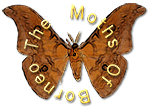|
||||||||||||||||||||||||||||||||||||
Volume
12
J.D.
HOLLOWAY
C.A.B. International Institute of Entomology, 56 Queen's Gate, London, SW7
5JR, U.K.
Abstract.
Bornean Noctuidae of the `trifine' subfamilies Noctuinae (11 spp.)
Heliothinae (2 spp.), Hadeninae (32 spp.), Acronictinae (7 spp.),
Amphipyrinae (121 spp.) and Agaristinae (14 spp.) are described following
an introductory section that considers the possible monophyly of the
Trifinae. Features such as the loss of vein M2 in the hindwing, presence
of complex hair-pencils in the base of the male abdomen, ornamentation of
the bursa copulatrix with band-like signa in the females and presence of a
costal process associated with the harpe in the male genitalia are used to
suggest relationships between the subfamilies.
Biogeographical and ecological patterns in the groups are discussed, and
host-plant specialisations noted. Arboreal feeding appears to be
primitive, with `higher trifines' tending to be open habitat specialists
and including economically important genera such as Agrotis,
Helicoverpa, Mythimna, Spodoptera, Athetis, Sesamia and Condica that
contain many species with large geographical ranges. Many montane taxa,
some with bipolar distributions, are also included.
The genus Sphetta (1 sp.) is transferred from Amphipyrinae to the
Notodontidae, together with the non-Bornean genus Cyphanta.
For each species a diagnosis and the geographical range are given and,
where known, details of habitat preference and biology. Summary lists are
provided of the new taxa described (3 genera, 28 species and 1 subspecies)
as well as numerous other taxonomic changes. There is a checklist of all
Bornean taxa.
Copyright © Southdene Sdn. Bhd. All rights reserved.
